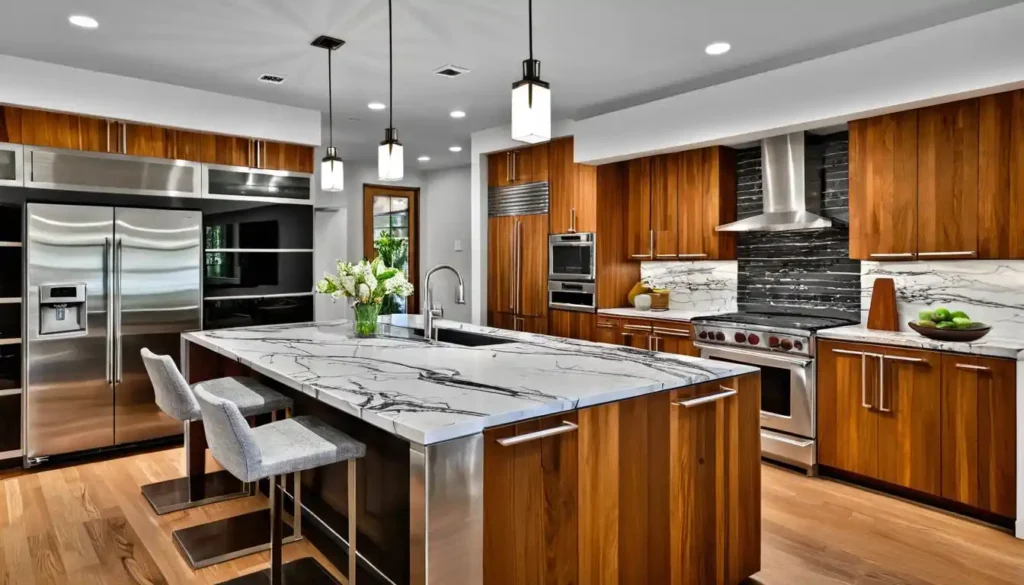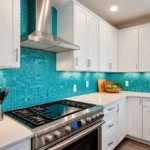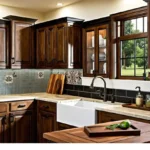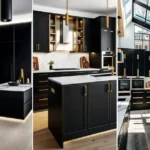Midcentury modern kitchens are not only a cool reference to the past, but they also represent the classic warmth and sense of style, straight lines and practical use of space as well as a perfect combination of wooden and color tones and light.

These kitchens are an ornate combination of natural motifs and functional shapes which allows these interiors to be easily incorporated into the modern domestic environment while preserving their unique character. Mid-century modern kitchen has a versatility that fits many home decors from the natural wood hue, smooth cabinet design and even vivid colors for the countertops.
What is a Midcentury Modern Kitchen?
The midcentury modern kitchen can also be described as simple, functional and with organic appeal. Common in kitchen designs from the mid-20th century, which ranged from the 1940s to the 1960s these kitchens are characterized by relative simplicity of the lines, lack of ornamentation, and natural textures. One of the characteristic features of shaker is its wood furniture, particularly the cabinetry of teak, walnut or oak shades, accompanied by earthen or natural tones. Further, an old-style refrigerator, conspicuous lampshades, and frame-less doors are the accessories that make up the whole outlook.
But what is characteristic now for midcentury modern kitchens is the possibility to transform them easily. While the contemporaries of this particular style of midcentury homes featured partially or fully separated and divided kitchen areas, many modern modifications incorporate the progressive concept of openness and the culinary zone as the centerpiece of the entire house. Large windows, seamless indoor-outdoor transitions, and ample use of natural light are frequently incorporated to maintain the connection to nature that was at the core of midcentury design.
Personalization in Midcentury Modern Kitchens
One special feature you can bring to your midcentury modern kitchen is personalization through sustainable choices. With the shift towards environmentalism in design, midcentury modern trend is the best approach to introduce environmentally friendly materials and energy conserving appliances to the structures without conceding the character of this style. For example:
- Sustainable Wood Options: Consider using reclaimed or sustainably sourced woods like bamboo or cork for cabinetry and flooring. These materials not only have the appearance of midcentury design and the feel of the period, but the appearance of sustainability as well.
- Energy-Efficient Appliances: Although midcentury kitchens incorporate equipment resistant to modern sophistication, it is possible to buy kitchen appliances that meet current U.S energy efficiency standards. This not only helps in the conservation of resources in your environment but also provides an added functional space to your house.
- Vintage + Modern Fusion: One exciting way to stand out is to mix original midcentury vintage pieces with contemporary touches. To achieve this stylish and ergonomic atmosphere, adding great examples of midcentury modern lighting or seating along with integrating contemporary wiring and smooth finishes into your kitchen can be helpful.
With such an approach, you make your midcentury modern kitchen warm and endlessly unique while also aligning with contemporary values and making the space timeless.
Continue reading – 13 Chic Modern Kitchen Decor Trends You’ll Love
1. Bring Nature Indoors With Earthy Color Palettes

Earth tones play a major role in mid-century modern kitchens, as they pull inspiration from nature. To give an idea of what kind of plants and colors to expect, just think of greens, browns, and mustard yellows. Best to match these colors with wooden cabinets to complete a welcoming atmosphere that would truly suit your kitchen. Using natural patterns, such as wooden grain tiles or forest green backsplashes can reinforce this experience of nature even further.
2. Streamlined Storage for Minimalist Appeal

Kitchens of the mid-century modern design are all about functionality and storage is used as the key element to keep everything as streamlined as possible. Choose furniture that is as much a part of the wall as possible and that has a lot of storage potential without being bulky. For example, built-in cabinets with wood or matte finishes can maintain the mid-century aesthetic while keeping clutter at bay.
3. Mix Bold Colors and Patterns

In mid-century modern kitchens one can experiment with the intensity of the hues and the most common places to do this is either the cabinets or the backsplash. Think about painting your cabinetry a teal color, deep orange color, or avocado green color. Interest can be introduced with geometric shapes in a form of floor tiles or a backsplash. The goal is to balance retro charm with modern sensibilities—perfect for creating a lively yet sophisticated space.
4. Choose Wood Tones That Evoke Warmth

What is more appropriate than wood for the mid-century modern design where it is used frequently? Ranges from the darker tones of walnut to the lighter shades of oak that is as important to let the grain of the wood comes through. When choosing wood shades, use contrasting wood shades which do not overwhelm the kitchen, for instance, matching the walnut cabinets with oak bar stools.
5. Embrace Open Shelving Over Upper Cabinets

A usual feature that is rarely seen in most mid-century designs is the lack of those large upper cabinets that protrude at the top. This also helps bring in more natural lighting, as well as helps to maintain the feeling of openness to the area. Choose stretches of white cupboards to bring focused pieces of kitchenware or art to the forefront since the open airiness of the kitchen is desirable. Subway tiles will fit perfectly into this minimalist design as this way you will keep the look sleek and simple, with no distractions from the lines of the building.
6. Add Statement Lighting Fixtures

Mid-century modern design is known for its eye-catching lighting fixtures. Recommended are pieces that are dramatic such as a Sputnik chandelier or geometric patterned pendants. Lighting is not only important for circulation and task but can also be used more sculpturally as a piece of furniture for the kitchen.
7. Maximize Natural Light

A key component of mid-century modern homes is the emphasis on natural light and the indoor-outdoor connection. Natural light from the sun through windows, skylights, or glass doors make the kitchen brighter and open to the environment making it larger. In order to improve this, it might be relevant to add midcentury modern kitchen lighting that will fit the atmosphere and your dining or preparing area will be illuminated by it.
8. Integrate Modern Appliances With Mid-Century Flair

While the mid-century look is timeless, today’s kitchens need modern functionality. Choose those which are interchangeable with the cabinetry for an optimum look. Appliances that mimic the look of designs from the 1950s, for example, a refrigerator that resembles a pale pink laundry tub or a stove with updated finishes, still allow the owner to reap the benefits of 21st century technology.
9. Add a Cozy Breakfast Nook

Primitive mid-century kitchen design can be elegant and comfortable at the same time. Introduce a breakfast nook with the bench seating as part of the construction and wooden accents or slats for a classic, warm appearance. This functional space provides the additional comfort of an eating space making this kitchen a warmer and more practical addition.
10. Flat-Front Cabinetry for Sleek Simplicity

Built-in cabinets, especially those which are flat-front and faced, are characteristic of mid-century modern furniture as they do not contain carvings and other over-embellishments. This minimalism can be complemented by vintage accessories such as chrome knobs or handles in matt black that help imbue the cabinets with sophistication.
Related – 35 Gorgeous Blue Kitchen Cabinets for Every Style
11. Experiment With Terrazzo Flooring

Terrazzo flooring is a perfect fit for mid-century modern kitchens. This gives an interesting texture with speckle and combination of colors used in making it could still be strong. To make the flooring a talk of the town select more natural colors or even more vibrant colors such as green or red flecks.
12. Create a Full Wall Backsplash

Do it big and make a statement by applying a backsplash across an entire kitchen wall. Choose a focal or accent wall and clad it with veined marble or brightly hued tiles to ensure that even with its large size it won’t look too busy. If you want to make your kitchen more fashionable, consider a mid-century modern kitchen backsplash that not only serves as a practical shield but also adds depth to the overall appearance of your kitchen.
13. Incorporate Retro Furniture Pieces

No mid-century modern kitchen is complete without iconic furniture. From the sleek Saarinen tulip table to molded Eames chairs, mid-century furnishings add authenticity to the design. These are practical but they are aesthetically pleasing, so you can use them in your kitchen for years.
14. Celebrate Exposed Beams and Natural Materials

Exposed wooden beams bring warmth and character to mid-century modern kitchens. Ideal combine these architectural features with wooden panels or ceilings, so as to increase the space’s natural shabby chic look. The use of wooden beams is also important; while it preserves the historical aspect of the house, the appliances used are thoroughly contemporary, which allows to maintain the balance between the traditional and the technical aspects of the house.
FAQs (FREQUENTLY asked questions)
1. What are key elements of mid-century modern kitchen design?
They include the aspect of sleekness, the aspects of wooden furniture finishes, earth toned color, furniture and lighting resembling the 70’s’. Modern kitchens work well to eliminate excessive or ornate features and focus on practicality of default, integrated shelving, and filled cabinets with flat fronts.
2. What colors are common in mid-century modern kitchens?
Such color prevails as green, mustard yellow, and brown can be distinguished as earth tones. However, riskier colors like teal, orange and avocado green are also applicable particularly in cabinets and backsplashes.
3. How can I make a mid-century modern kitchen feel contemporary?
Add some features to the design such as integrated appliances, a low-profile use of hardware and open floor concepts. Mixing classic mid-century materials with contemporary finishes—like matte black fixtures or terrazzo floors—can give the space a modern edge without losing its retro charm.












